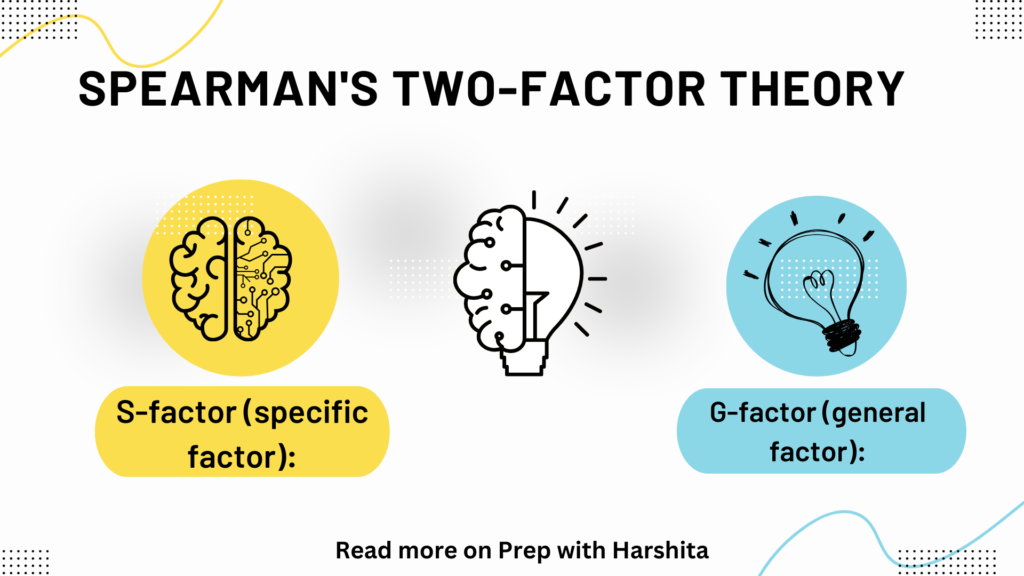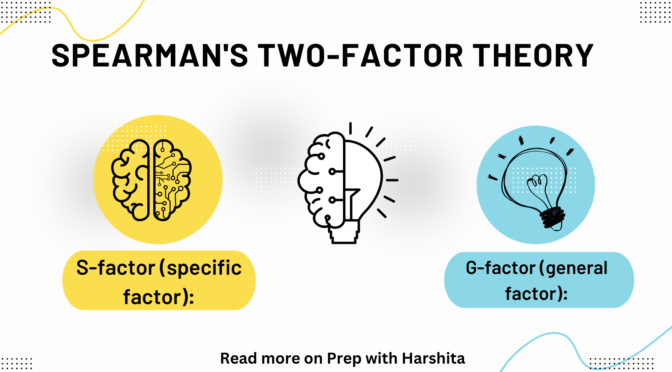Spearman’s Two-Factor Theory of intelligence, which was proposed by British psychologist Charles Spearman in the early 20th century. This theory suggests that intelligence is composed of two factors: the general factor (g) and specific factors (s).
General Factor (g):
According to Spearman, there is a single, underlying general intelligence factor (g) that influences performance on all cognitive tasks. This general factor represents an individual’s overall cognitive ability and is responsible for the positive correlation observed between various intellectual tasks. In other words, people who perform well on one type of cognitive task are likely to perform well on others.
Also Read : Inquiry Teaching Model
Specific Factors (s):
In addition to the general factor, Spearman acknowledged that there are specific abilities (s) that are unique to particular tasks. These specific factors are not as pervasive or influential as the general factor but contribute to performance on specific types of cognitive tasks.
Spearman’s Two-Factor Theory has been influential in the history of intelligence research, and the general factor (g) is still considered by many as a key component of intelligence. However, contemporary theories of intelligence have expanded beyond Spearman’s model, incorporating multiple intelligences and considering other factors such as emotional intelligence. While the concept of a general factor remains, the understanding of intelligence has become more diverse over time.
Also Visit: Prep with Harshita



Thank you for your sharing. I am worried that I lack creative ideas. It is your article that makes me full of hope. Thank you. But, I have a question, can you help me?
https://microsoft-powerpoint-2010.softonic.kr/download
https://nicesongtoyou.com/welfare/support-fund/
아름다운스웨디시업소
https://www.youtube.com/@GILMONG201
대전나이트클럽
https://mintfin.tistory.com/tag/Ethereum
https://www.youtube.com/channel/UCeVNIN2PoYFRDmFyYRmK7bQ
https://edithvolo.com/page/146/
https://new-software.download/windows/naver-now/
https://www.youtube.com/@TV신호등
https://www.youtube.com/channel/UCe0Qrv4HvRK_iup3X_cNdBA
https://www.youtube.com/@TV신호등
https://www.youtube.com/@trot-workshop
https://www.youtube.com/@소중한인연-c1u
https://www.youngstarmedia.com/
하동동해출장만남 소자본 창업
https://www.youtube.com/@소중한인연-c1u
https://www.youtube.com/channel/UCyt2dGrKTf9KpBk1jdUl3oA
벼룩시장 구인구직 및 신문 그대로 보기 (PC/모바일) | 구인구직 앱 어플 무료 설치 다운로드 | 모바일 벼룩시장 보는 방법 | 벼룩시장 부동산 | 지역별 벼룩시장 | 벼룩시장 종이신문 에 대해 알아보겠습니다. 섹스카지노사이트
https://www.youtube.com/channel/UCyt2dGrKTf9KpBk1jdUl3oA
https://www.youtube.com/channel/UCeVNIN2PoYFRDmFyYRmK7bQ
https://www.youtube.com/@가요여행
https://www.youtube.com/@소중한인연-c1u
https://www.youtube.com/channel/UCeVNIN2PoYFRDmFyYRmK7bQ
https://www.youtube.com/@가요여행
https://www.youtube.com/@소중한인연-c1u
https://www.youtube.com/channel/UCe0Qrv4HvRK_iup3X_cNdBA
https://www.youtube.com/@영스타미디어
https://www.youtube.com/channel/UCJLXoLNzHeK70WCJlQNYf-g
https://kleonet.com/entry/히어로는아닙니다만-재방송/
https://www.youtube.com/@BIMONG
https://nicesongtoyou.com/tax/eca285ed95a9ec868ceb939dec84b8/
https://www.youtube.com/@DaftTaengk
https://www.youtube.com/channel/UCyxM_MlJsJQaQSuJ8lR58tg